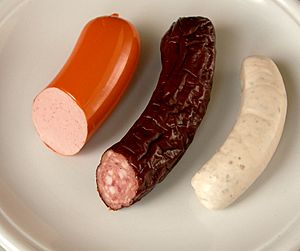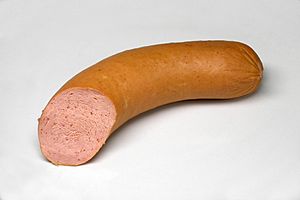Brühwurst facts for kids

Various cooked sausages: Lyoner, Austrian smoked sausage and veal sausage
|
|
| Type | Sausage |
|---|---|
| Place of origin | Germany |
Brühwurst is a special type of sausage from Germany. Its name means "scalded sausage" or "parboiled sausage." This tells us how it's made! Unlike raw sausages, Brühwurst is always cooked by being scalded (heated in hot water).
These sausages are usually made from finely chopped raw meat. Sometimes, they are also smoked to add extra flavor. You'll typically find Brühwurst served hot. In English-speaking countries, you might know similar sausages as hot dogs or kielbasa.
What Makes Brühwurst Special?
The way Brühwurst is made gives it a unique texture. The meat used has a special ability to hold water, which is important for the sausage's consistency. In the past, sausages were often made right after an animal was slaughtered, when the meat was still warm. Today, they use chilled or aged meat.
Making Brühwurst also involves making sure the fat stays stable and the sausage forms a good, firm shape. This process is called gelation, which helps the sausage hold together perfectly.
Different Kinds of Brühwurst
In Germany, Brühwurst sausages are sorted into four main groups based on how they are made and what they contain:
- Cooked Sausages: These are fully cooked and ready to eat. Examples include frankfurters and Debrecener.
- Boiled Sausages (Minced): These sausages are made from very finely minced meat. Good examples are Lyon, Weisswurst (white sausage), and Burenwurst.

- Coarse Cooked Sausages: These have a coarser texture, meaning the meat isn't chopped as finely. You might find smoked sausage, Krainer sausage, and Krakauer in this group.
- Cooked Sausages with Inserts: These sausages have extra ingredients mixed in, like cheese or pieces of ham. Käsekrainer (cheese sausage) and ham sausage are popular types.
Other types of Brühwurst include Bierschinken, Knackwurst, and Bierwurst.
Brühwurst as Army Food
Long ago, Brühwurst was a useful food for armies. It was chosen because it didn't spoil easily and didn't need to be kept cold in a refrigerator. This made it a great option for soldiers who were on the move, providing them with food that was similar to fresh products but much easier to carry and store.
See also
 In Spanish: Brühwurst para niños
In Spanish: Brühwurst para niños

